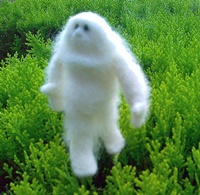Yeti is a cross between bear species: DNA research
18 Oct 2013
The mystery of the Yeti, the supposed 'missing link' in the evolution of man from primates may have been finally solved thanks to DNA research.
 Tests conducted on hair samples have shown a genetic match of the Yeti with an ancient polar bear.
Tests conducted on hair samples have shown a genetic match of the Yeti with an ancient polar bear.
Scientists believe there could be a sub species of brown bear in the High Himalayas that had been mistaken for the mythical beast.
Records of close encounters with the Yeti, the ''Abominable Snowman'' or ''Bigfoot'' in the Himalayas, go back to centuries in local history.
Bryan Sykes, professor of human genetics at the Oxford University, set out to collect and test ''yeti'' hair samples to find out which species they originated from.
He specifically analysed hair samples from two unknown animals, one found in the Western Himalayan region of Ladakh and the other from Bhutan, 800 miles to the east.
On conducting the most advanced DNA tests available and comparison of the results with other animals' genomes stored on the GenBank database, professor Sykes found that he had a 100 per cent match with a sample from an ancient polar bear jawbone found in Svalbard, Norway, dating back between 40,000 years and probably around 120,000 years - a time marking the separation of the polar bear from the closely related brown bear as different species.
According to the professor, this was an exciting and completely unexpected result that came as a surprise.
He added, there was more work to be done on interpreting the results, but he did not think it meant there were ancient polar bears wandering around the Himalayas.
But he said there could be speculation on what the possible explanation might be. It could mean there was a sub species of brown bear in the High Himalayas descended from the bear that was the ancestor of the polar bear, or it could mean there had been more recent hybridisation between the brown bear and the descendent of the ancient polar bear.
British climber Eric Shipton had photographed a ''yeti'' footprint in 1951 which sparked a global mania.
Legendary mountaineer Reinhold Messner, the first man to climb Everest without oxygen, has studied yetis following a terrifying encounter with a mysterious creature in Tibet in 1986.
Researching the creature, Messner came across an image in a 300-year-old Tibetan manuscript of a "Chemo" - another local name for the yeti.
The tex alongside it read in the local language: "The yeti is a variety of bear living in inhospitable mountainous areas."
According to commentators this seems to back up professor Sykes' theory.













.jpg)






.jpg)









